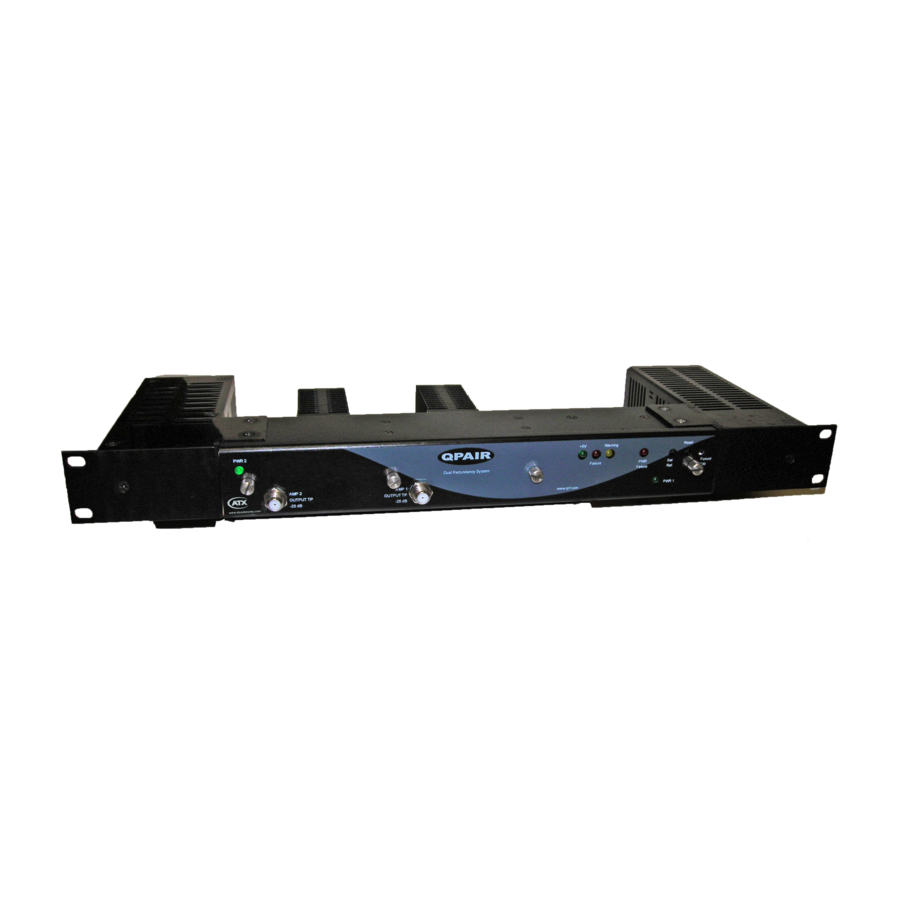ATX Q series Manual de instalação e operação - Página 9
Procurar online ou descarregar pdf Manual de instalação e operação para Amplificador ATX Q series. ATX Q series 18 páginas. Qpair redundancy switch amplifier system

CHAPTER 2: DESCRIPTION OF OPERATION
DESCRIPTION OF OPERATION
2.
Description of Operation
(Refer to Figure 2 and Figure 6 for location of switches, push buttons, and LEDs)
RF output levels of both the primary and the secondary amplifiers are sampled and this sample is converted to a voltage
value. At initial power on or when the reset button is pushed, the system is switched to run on the primary amp (AMP 1). The
yellow LED will flash slowly indicating the reference levels need to be set. By pressing the SET REF button, the microcontroller
samples the output values of both the primary amp and the secondary amp and stores the values as references. These
values will be used to compare with the sampled output values of both amplifiers to confirm proper levels. At any time during
the operation, one can always press RESET to reset the microcontroller program. Then push SET REF to store the new
sampled values.
During normal operation, if both outputs are within 3 dB (factory programmable) of the reference values, no action will be
taken. If the primary amp is down 3 dB or more and the secondary amp is not, the system considers the primary amp failed
and will switch to the secondary amp, set the alarm, and set the red failure LED on. The microcontroller cannot perform any
additional switches because the detectors are unable to sample the signal when the secondary amplifier is activated (see
Figure 6). You will need to troubleshoot or replace the primary amplifier. See Appendix 3 for troubleshooting instructions
or Appendix 2 for replacing the amplifier module. After the amplifier problem is resolved, you need to reset the system by
pushing the RESET button. Set the levels according to the setup procedure and store levels by pushing the SET REF button.
If both outputs are down 3 dB or more, the system considers the input is low and will set the red LED flashing quickly and
set the alarm. After resolving the low input level problem, set the system output levels according to the setup procedure. To
restore normal operation push the RESET button and then push the SET REF button.
If the system is running on the primary amp and the secondary amp level is down 3 dB or more, the system considers the
secondary amp failed and will set the alarm and set the red LED flashing slowly. You need to troubleshoot or replace the
secondary amplifier. See Appendix 3 for troubleshooting instructions or Appendix 2 for replacing the amplifier module. After
the amplifier problem is resolved, you need to reset the system by pushing the RESET button. Set the levels according to the
setup procedure and store levels by pushing the SET REF button.
The signal level within the bandwidth of the primary amplifier coming into the RF switch compartment should be limited to
not more than 50 dBmV per channel. However, if only part of the TV channel spectrum is used, the maximum signal level per
channel may be higher than 50 dBmV and the minimum signal level should be higher than 20 dBmV. If needed, contact ATX
Networks for assistance in calculating the correct levels.
The recommended primary or secondary amplifier output level is between 20 dBmV and 50 dBmV with all the TV channels
loaded within the passband. The secondary amplifier operates 25 dB lower than the primary amplifier during normal operation
and is switched to full output level when a switch to the secondary amplifier is made. The reduced level of the secondary
amplifier during normal operation adds to the isolation between the outputs of the two amplifiers.
The system stores the reference levels to the non-volatile EEPROM memory in the microcontroller. When a power outage
occurs and power is restored, the QPAIR will wait for three minutes for the user to press the SET REF button. If the user does
not press the SET REF button within 3 minutes, the microcontroller will retrieve the stored reference levels from memory.
The system will also warn the user with a steady yellow LED light when it's using the retrieved reference levels after a
power interruption. To clear the yellow warning light, we recommend you reconfirm the output RF levels by using the setup
procedure.
During normal operation the alarm contacts are energized (i.e. the Normally Open contact is connected to the Common
contact). This configuration ensures that the user be alerted when power goes down.
Q-Series
Amplifiers – QPAIR Redundant Amplifier System – Installation & Operation Manual
2-1
®
